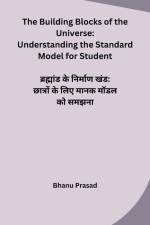av Bhanu Prasad
331
Since the dawn of time, humans have gazed up at the starry sky and wondered about the universe. What is it made of? Where did it come from? Are we alone?These questions have fascinated generations and inspired scientists to seek answers. In this book, we will embark on an exciting journey to explore the building blocks of the universe and learn about the Standard Model, a powerful theory that attempts to explain all of the matter and energy that exists around us.Scientists have been observing the sky to study the universe since ancient times. They named constellations, mapped the motion of planets, and tried to catch a glimpse of distant galaxies.In early ideas, the universe was thought to be static and centered on Earth. However, as our technology improved, scientists began to understand that the universe is actually very large, constantly expanding, and incredibly dynamic.Today, we have modern telescopes, spacecraft, and sensors that allow us to explore the farthest corners of the universe. We can observe the birth and death of stars, uncover the mysteries of black holes, and even see the initial moments of the universe's creation.The universe is made up of two basic types of particles: fundamental particles and composite particles. Fundamental particles are the smallest units of matter that cannot be broken down into anything smaller. Composite particles are made up of two or more fundamental particles.The fundamental particles of the universe are:· Quarks: Quarks are the building blocks of protons and neutrons, which in turn are the building blocks of nuclei. There are six types of quarks: up, down, strange, charm, bottom, and top.· Leptons: Leptons are another type of fundamental particle. They do not interact with the strong force, which is the force that holds nuclei together. There are six types of leptons: electron, muon, tau, and their associated neutrinos.· Bosons: Bosons are a third type of fundamental particle. They mediate the four fundamental forces of nature: gravity, electromagnetism, the strong force, and the weak force.


